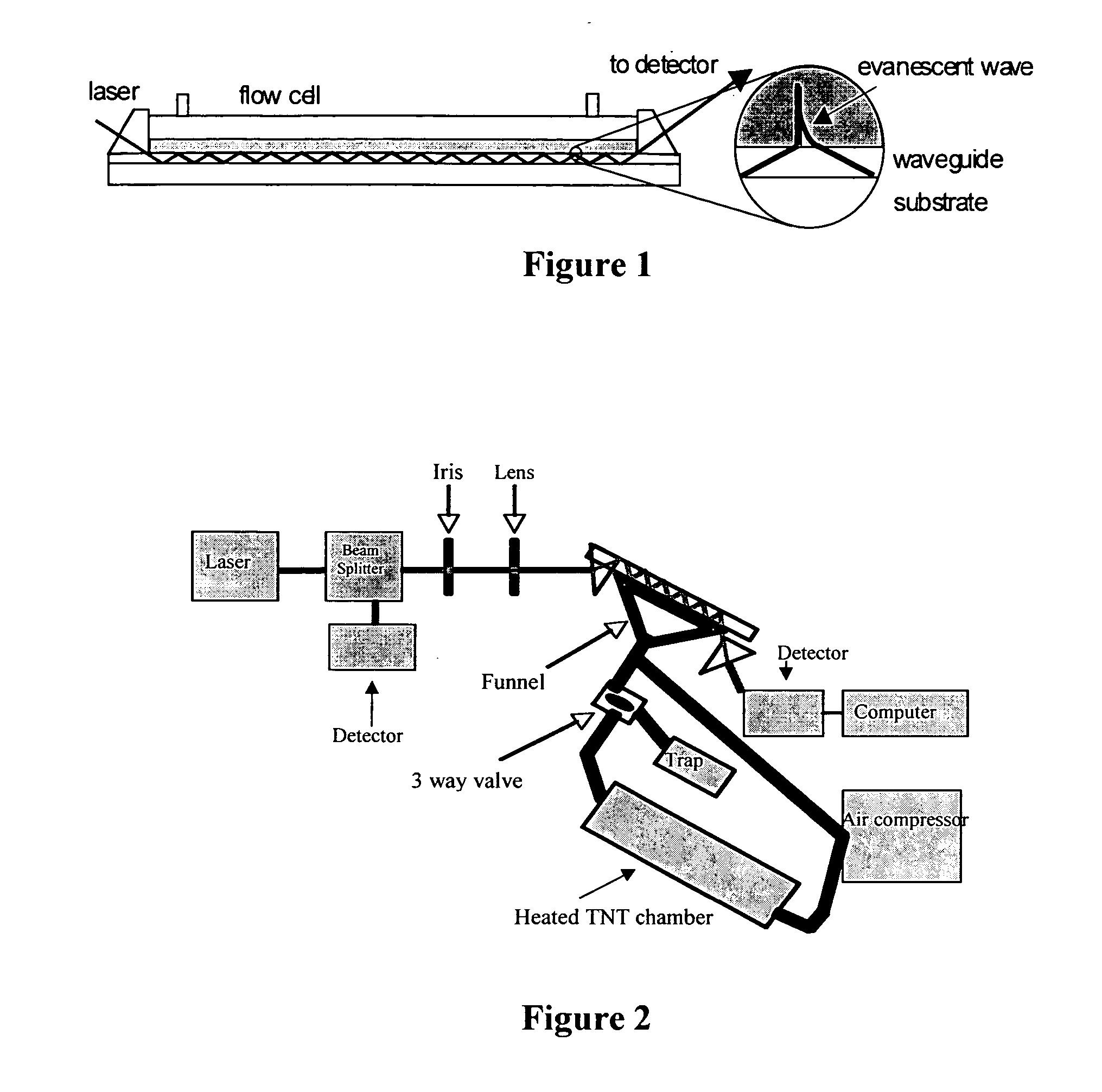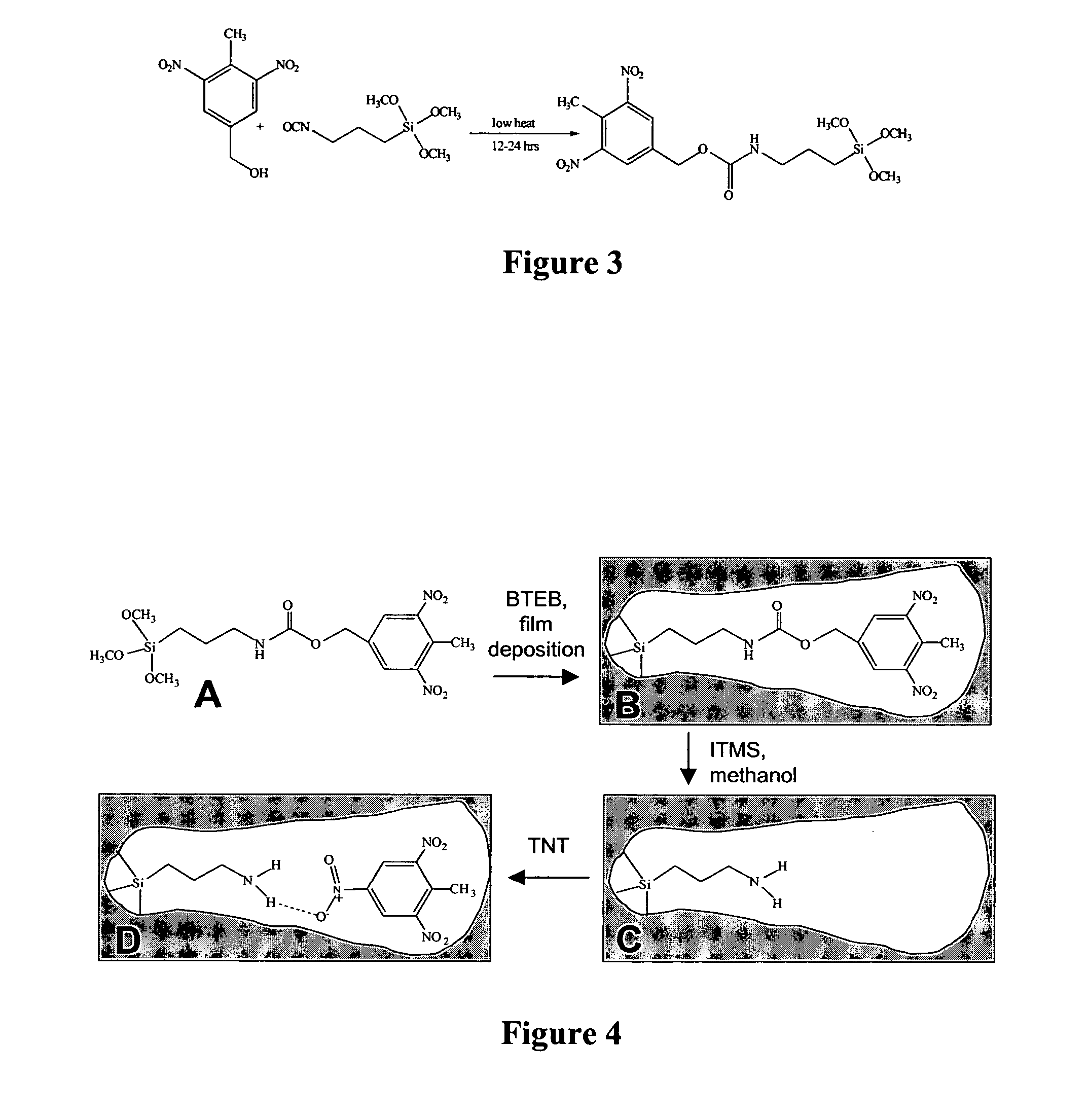TNT sensor containing molecularly imprinted sol gel-derived films
- Summary
- Abstract
- Description
- Claims
- Application Information
AI Technical Summary
Benefits of technology
Problems solved by technology
Method used
Image
Examples
example 1
Synthesis of Polymerizable Methyl Dinitrobenzene (mDNB) Alkoxysilane Monomer
[0068] One alkoxysilane monomer that was used (in subsequent examples) to imprint sensing films contained the TNT analog mDNB. The monomer was synthesized by reacting 3-isocyanatopropyltrimethoxysilane and 4-methyl-3,5-dinitrobenzyl alcohol in a 1:1 molar ratio at 50° C. for 24 hr (FIG. 3). An IR spectrum and nuclear magnetic resonance (NMR) spectra were taken of the product to confirm completion of the reaction. FT-IR confirmed the disappearance of the O═C═N peak at 2200 cm−1 and the appearance of the C═O peak at 1650 cm−1. The product was also confirmed by 400 MHz 1H NMR. The mDNB was dissolved in THF for subsequent manipulations.
[0069] The mDNB template could not be stored for long periods of time because, as indicated by IR analysis, composition changes consistent with hydrolysis and possibly partial condensation were detected (by color change). Side reactions causing dimerization of mDNB were most lik...
example 2
Synthesis of Polymerizable 5-nitro-m-xylene diol (DIOL) Alkoxysilane Monomer
[0070] A second alkoxysilane monomer that was used (in subsequent examples) to imprint sensing films contained the TNT analog 5-nitro-m-xylene-α,α′-diol. The monomer was synthesized by reacting 5-nitro-m-xylene-α,α′-diol is reacted with 3-isocyantopropyl triethoxysilane in a 1:1 molar ratio at 50° C. for 24 hr. FT-IR confirmed the disappearance of the O═C═N peak at 2200 cm−1 and the appearance of the C═O peak at 1650 cm−1. The product was also confirmed by 400 MHz 1H NMR. The DIOL was dissolved in THF for subsequent manipulations.
example 3
Waveguide Fabrication
[0071] Integrated optical waveguides were fabricated as described previously (Yang et al., Anal. Chem. 66:1254-1263 (1994), which is hereby incorporated by reference in its entirety) by dip-coating a waveguide sol-gel solution onto a transparent glass substrate.
[0072] The waveguide sol-gel solution was prepared by mixing 30 mL of methyl-trimethoxysilane, 15 mL of titanium(IV) tetrabutoxide, and 60 mL of ethanol. Polymerization was catalyzed by the addition of 3 mL of silicon(IV) chloride. After aging the sol-gel solution for at least 24 hr, films were deposited by dip-coating a glass microscope slide withdrawn from the sol-gel solution along its long axis at a rate of 5-10 cm / min. The films were then annealed at 510° C.-520° C. for 15 min and cooled to room temperature before coating with the sensing film.
PUM
 Login to View More
Login to View More Abstract
Description
Claims
Application Information
 Login to View More
Login to View More - R&D
- Intellectual Property
- Life Sciences
- Materials
- Tech Scout
- Unparalleled Data Quality
- Higher Quality Content
- 60% Fewer Hallucinations
Browse by: Latest US Patents, China's latest patents, Technical Efficacy Thesaurus, Application Domain, Technology Topic, Popular Technical Reports.
© 2025 PatSnap. All rights reserved.Legal|Privacy policy|Modern Slavery Act Transparency Statement|Sitemap|About US| Contact US: help@patsnap.com



